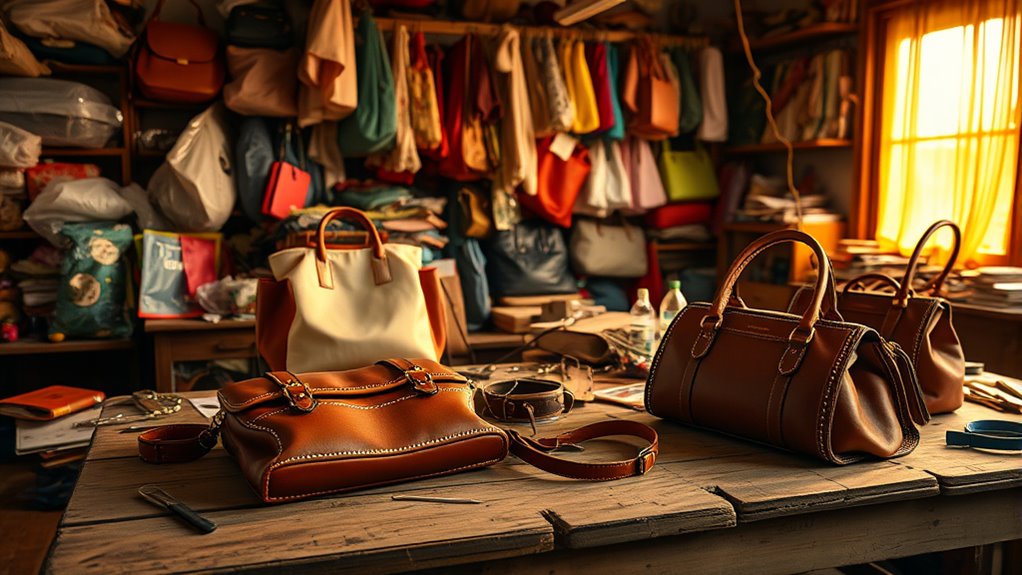Fast fashion’s focus on quick, low-cost production is diminishing handbag craftsmanship by prioritizing speed over quality and traditional skills. This shift leads to the decline of artisanal techniques, replaced by synthetic materials that are less durable. Mass production often sacrifices detail and durability, making handbags more disposable. Consumer demand for affordable, trendy items fuels this change, threatening craftsmanship and cultural heritage. To discover how this impacts craftsmanship further, explore what the industry foresees for artisanal handbag making.
Key Takeaways
- Fast fashion prioritizes rapid, low-cost production, reducing emphasis on traditional craftsmanship and detailed handwork.
- The industry’s focus on quick turnaround diminishes quality control and craftsmanship integrity in handbag manufacturing.
- Traditional artisanal techniques are fading as skills are not passed down, leading to cultural and craftsmanship decline.
- Use of synthetic materials and shortcuts compromises handbag durability and the preservation of craft standards.
- Trend-driven, mass-produced handbags overshadow timeless design, limiting creativity and undermining craftsmanship heritage.
The Rise of Fast Fashion and Its Industry Goals

Fast fashion has dramatically transformed the apparel industry by prioritizing rapid production and low costs. You’ve likely noticed how brands produce new styles in record time, aiming for a quick turnaround from design to store shelves. This approach relies heavily on mass production, allowing companies to churn out large quantities of trendy handbags and clothing at minimal expense. The goal is to meet consumer demand instantly, offering affordable options that keep shoppers coming back for more. Fast fashion’s focus on speed means that brands can respond quickly to changing trends, often pushing out new collections weekly. While this boosts profits and keeps inventories fresh, it also emphasizes quantity over quality, shaping a landscape where speed and mass production dominate the industry. This relentless focus can also compromise the craftsmanship and quality control traditionally valued in handbag making. Additionally, the emphasis on rapid turnover can lead to a decline in artisan skills, affecting the unique character of handcrafted accessories and further diminishing the value placed on handcrafted techniques. Moreover, this trend has led to a loss of traditional craftsmanship, as quick manufacturing processes replace detailed, skillful handiwork with automated methods.
Erosion of Traditional Craftsmanship Skills
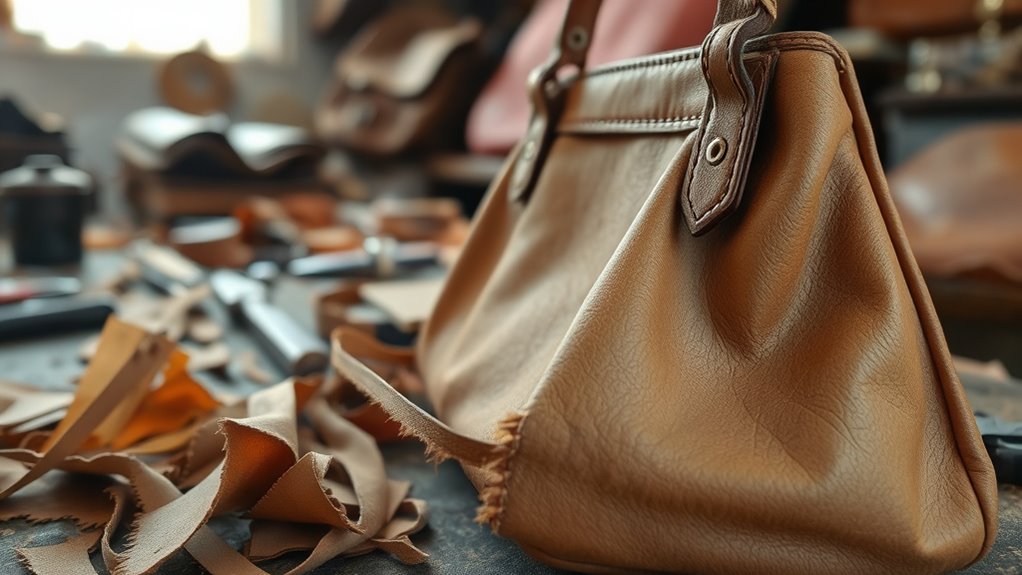
You may notice that many artisanal techniques are fading as fast fashion dominates the market. Traditional heritage methods are disappearing, leaving a gap in handcrafted craftsmanship. As skills are no longer passed down, the rich history behind handbag making risks being lost forever. Moreover, the rise of self watering plant pots practices reflects a broader trend of technological influence impacting traditional skills and knowledge.
Decline in Artisanal Techniques
As mass production and rapid fashion cycles dominate the industry, traditional artisanal techniques are increasingly fading into obscurity. This decline threatens cultural preservation, as handcrafted methods carry historical significance and unique craftsmanship passed down through generations. When these techniques diminish, the artistic integrity of handbag making suffers, reducing each piece to mere commodities rather than expressions of artistry. You might notice how modern brands prioritize speed over skill, neglecting the intricate details that define artisanal work. As a result, the rich heritage embedded in craftsmanship risks being lost forever. To protect this legacy, it’s essential to recognize the value of these skills and support artisans committed to maintaining traditional methods, ensuring that craftsmanship remains vibrant and culturally meaningful. Additionally, promoting awareness of traditional techniques can help preserve the artistry behind handcrafted handbags for future generations. Recognizing the importance of cultural heritage in craftsmanship is crucial for sustaining these artisanal traditions, especially as craftsmanship skills face ongoing erosion in today’s fast-paced fashion industry.
Loss of Heritage Methods
The erosion of traditional craftsmanship skills in handbag making accelerates as younger generations overlook or abandon age-old techniques. This shift threatens heritage preservation, risking the loss of cultural significance embedded in handcrafted methods. When artisans pass away without passing down their skills, invaluable knowledge fades, diminishing the unique identity of regional craftsmanship. The importance of heritage preservation becomes increasingly evident as these skills wane, emphasizing the need to maintain artisanal traditions. Fast fashion’s focus on speed and low costs discourages investment in time-intensive, heritage-rich techniques, leading to their decline. As these methods disappear, so does the cultural story behind each piece, eroding the rich history that once defined craftsmanship communities. Without conscious efforts to preserve these heritage methods, future generations may never experience the artistry and cultural depth woven into traditional handbag making. This loss weakens the cultural fabric tied to artisanal craftsmanship, which is often celebrated in preppy dog names and other cultural expressions. Additionally, emphasizing leadership skills within the industry could promote initiatives aimed at safeguarding these traditional techniques and fostering a new appreciation for craftsmanship heritage. Recognizing the importance of preservation efforts is crucial to maintaining the integrity and diversity of handbag craftsmanship traditions. Moreover, integrating water-based techniques can help revive some of these skills by highlighting their environmental benefits and artisanal value.
Diminished Skill Transmission
When traditional craftsmanship skills are no longer passed down through generations, the knowledge and techniques that define regional handbag making begin to fade. Without active skill transmission, artisans lose access to traditional techniques that preserve the authenticity of their craft. This erosion hampers skill retention, making it harder for new generations to master intricate details like hand-stitching or delicate embellishments. As a result, craftsmanship becomes less precise and less unique, diminishing the cultural value of handmade handbags. Fast fashion’s emphasis on rapid production and low costs accelerates this decline, discouraging apprenticeships and hands-on learning. When skill transmission diminishes, the rich heritage of handbag craftsmanship risks disappearing, leaving only mass-produced imitations that lack the artistry of traditional methods. Eco-friendly materials and sustainable practices could help preserve some traditional techniques by encouraging more mindful craftsmanship. Additionally, the decline in craftsmanship skills hampers the ability to innovate within traditional methods, further threatening the preservation of regional styles. The loss of specialized techniques also reduces the distinctiveness that makes regional handbags unique. Moreover, resources and tools play a vital role in supporting artisans and maintaining craftsmanship standards. Supporting training programs can also help ensure the continuity of skilled artisans and the preservation of regional techniques.
Changes in Material Selection and Quality Standards
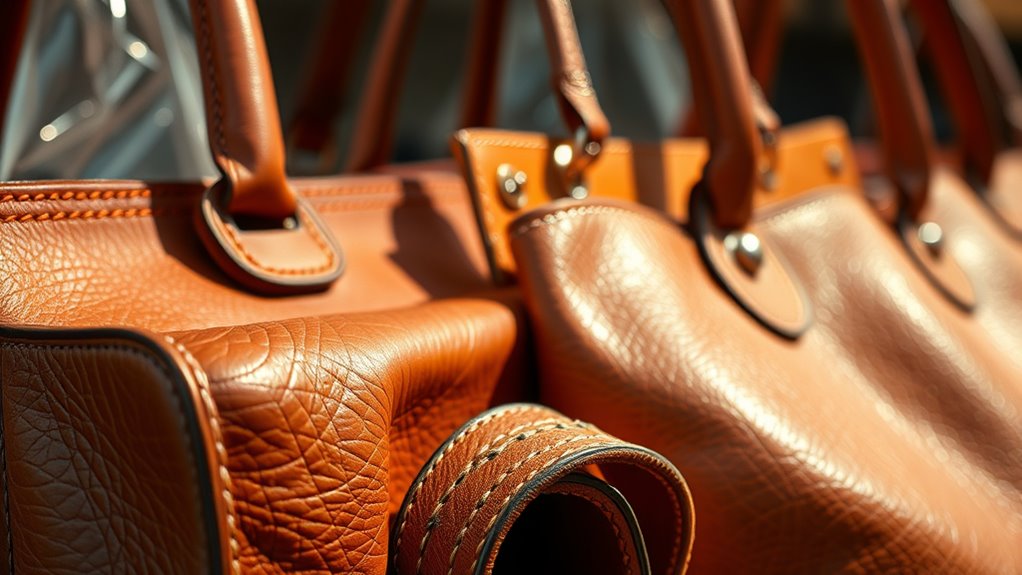
You may notice that fast fashion brands often choose synthetic materials over traditional leather or fabric. This shift helps cut costs but also lowers the overall durability of handbags. As a result, quality standards are often sacrificed to meet quick production timelines.
Shift to Synthetic Materials
As fast fashion accelerates, designers increasingly turn to synthetic materials to meet demand for affordability and quick turnaround times. This shift fuels synthetic innovation, leading to a broader material diversification in handbag production. You’ll notice more faux leather, polyester blends, and innovative plastics replacing traditional materials. These synthetics often cost less and are easier to produce at scale, but they also alter quality standards. The focus shifts from craftsmanship to mass efficiency, impacting durability and tactile qualities. Additionally, the environmental implications of synthetic materials are prompting ongoing discussions about sustainable practices within the industry. The use of material testing ensures these synthetics meet safety and quality requirements, even as standards shift.
Lowered Durability Expectations
The shift toward synthetic materials has led to lowered durability expectations in handbag manufacturing. Manufacturers often prioritize cost-cutting over material longevity, resulting in products that don’t last as long. These cheaper materials are less resistant to wear, tearing, and environmental damage, which diminishes the lifespan of handbags. As a result, craftsmanship standards decline because less attention is given to ensuring quality and long-term performance. Consumers become accustomed to replacing handbags frequently, which reinforces the cycle of low durability. This shift affects not only the product’s lifespan but also the perception of quality in handbag craftsmanship. Additionally, the emphasis on fast production often leads to corners being cut in the manufacturing process, further compromising product integrity. The reduced focus on material quality standards contributes to a decline in overall craftsmanship integrity. Ultimately, the focus on fast production and inexpensive materials compromises the integrity and durability that once defined high-quality craftsmanship.
The Pressure for Rapid Production and Its Consequences
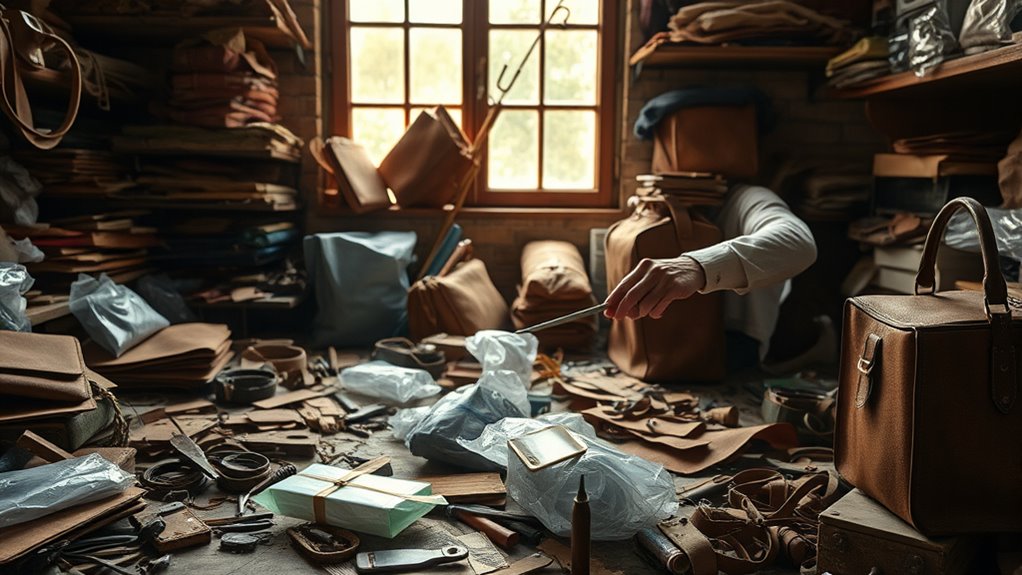
The demand for fast fashion has driven manufacturers to prioritize speed over quality, often leading to rushed production schedules. This focus on rapid turnaround fosters mass production, where large quantities of handbags are made quickly to meet trends. However, this approach causes a quality compromise, as craftsmanship takes a backseat to meeting tight deadlines. You might notice that these handbags lack the durability and attention to detail that traditional craftsmanship offers. The pressure to produce quickly reduces the time spent on quality control and fine finishing. As a result, you receive products that are less sturdy, with materials and stitching that may not hold up over time. This relentless push for speed ultimately diminishes the overall craftsmanship of handbags.
Consumer Preferences and the Demand for Affordable Trends
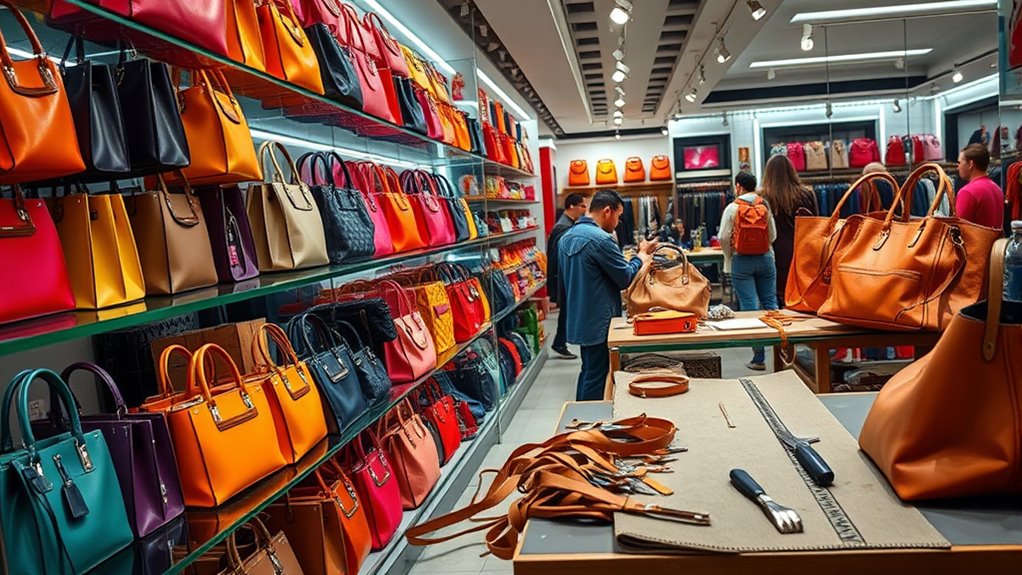
Consumers today prioritize affordability and staying on top of the latest trends, often choosing fast fashion handbags over handcrafted options. You want stylish pieces that fit your budget and reflect current fashion, even if it means sacrificing quality and craftsmanship. Fast fashion brands leverage luxury branding techniques to create an illusion of exclusivity, making trendy bags seem more desirable. However, this shift in preferences has impacted the demand for traditional craftsmanship. While some consumers are becoming more aware of sustainable practices, many still prioritize low prices and rapid turnover. As a result, the focus remains on quick production and disposable fashion, which challenges the longevity and value of handcrafted handbags. Your choices influence the market, often favoring affordability and trendiness over durability and artisanal quality.
How Fast Fashion Is Reshaping Design and Innovation

Fast fashion accelerates design cycles, pushing brands to produce new styles at an unprecedented pace. To keep up, designers focus on rapid development, often prioritizing quick turnaround over craftsmanship. This shift encourages the use of innovative materials that can be sourced and manufactured swiftly, though sometimes at the expense of durability and sustainability. As a result, sustainable design takes a backseat, and trends dominate over timeless quality. However, some brands are beginning to explore eco-friendly materials and smarter designs to appeal to conscious consumers. You’ll notice that this relentless push for speed often limits creativity, favoring mass-produced, trend-driven handbags. While innovation in materials can inspire new aesthetics, it also challenges traditional craftsmanship and the long-term value of handcrafted pieces.
The Future of Artisanal Handbag Making in a Fast-Paced Market
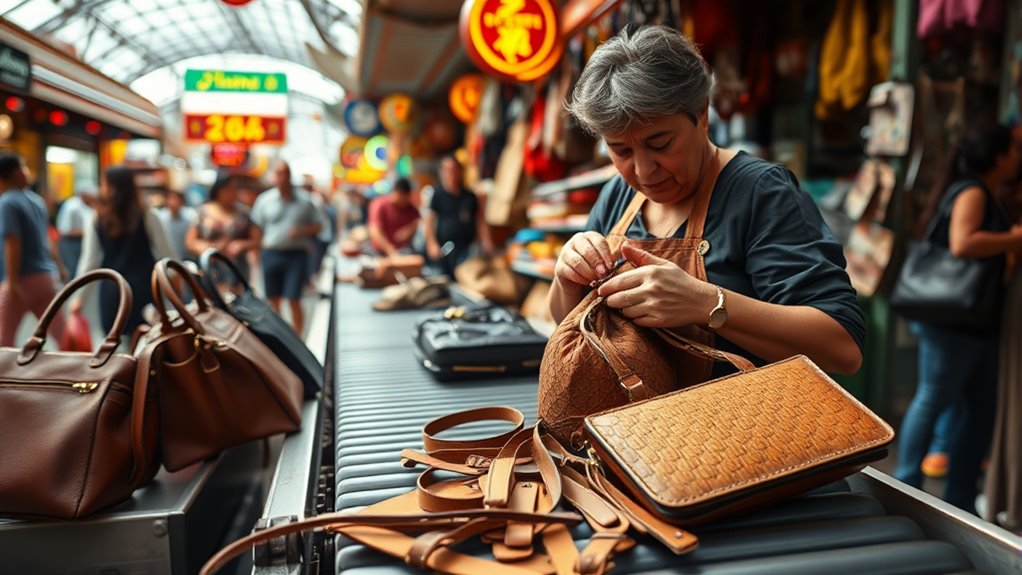
As the rapid pace of fast fashion continues to dominate the market, artisanal handbag makers face both challenges and opportunities to stand out. To thrive, you’ll need to embrace sustainable practices and prioritize ethical sourcing. Future success depends on your ability to connect with consumers who value transparency and craftsmanship. You might consider integrating eco-friendly materials or transparent supply chains to differentiate your brand. Emphasizing the story behind each handbag, from sourcing to production, can build loyalty. Additionally, collaborating with local artisans or adopting innovative, time-efficient techniques can help you stay competitive. By balancing tradition with modern practices, you can carve out a niche that appeals to conscious shoppers seeking quality over quantity. The future hinges on your adaptability and commitment to responsible craftsmanship.
Frequently Asked Questions
How Does Fast Fashion Influence the Pricing of Handcrafted Handbags?
Fast fashion drives down prices, making handcrafted handbags seem more expensive by comparison. You’ll notice mass production lowers costs, but it also puts pressure on handmade pieces to compete. Designer collaborations aim to elevate craftsmanship, yet fast fashion’s quick turnaround and volume often overshadow these efforts. As a result, consumers may undervalue the skill and time behind handcrafted handbags, influencing their pricing and perceived worth.
Are There Sustainable Practices Within Fast Fashion Handbag Production?
You might think fast fashion can’t be sustainable, but some brands do incorporate ethical sourcing and eco-friendly materials. They’re adopting practices like using recycled fabrics and ensuring fair labor, which shows that quick production doesn’t always mean harm. While not universal, these efforts prove that fast fashion can, in some cases, prioritize sustainability. By choosing brands that focus on these practices, you help support a more responsible industry.
Can Traditional Handbag Craftsmanship Survive in a Fast-Paced Industry?
You might wonder if traditional handbag craftsmanship can survive in today’s fast-paced industry. The answer lies in heritage preservation and artisan resilience. By valuing handcrafted techniques and supporting local artisans, you help guarantee these skills don’t fade away. Embracing slow fashion and quality over quantity empowers artisans to thrive, allowing craftsmanship to flourish amid rapid trends. Your choices can make a difference in safeguarding this timeless art for future generations.
What Role Do Consumers Play in Preserving Handbag Artisanal Skills?
Ever wonder how your choices can save artisanal handbag skills? By increasing your consumer awareness and prioritizing ethical purchasing, you directly support traditional craftsmanship. When you choose handmade over mass-produced, you help preserve these skills for future generations. Your purchasing decisions send a powerful message to brands to value quality and craftsmanship, ensuring these artisanal techniques continue thriving in a fast-paced industry. Ultimately, your role is vital in maintaining the legacy of handbag artisans.
How Might Technology Impact the Future of Handcrafted Handbag Making?
Technology could revolutionize handcrafted handbag making by offering digital customization, allowing you to personalize designs easily. Automated sewing tools can increase precision and efficiency, freeing artisans to focus on intricate details and quality. You might find that these innovations help preserve craftsmanship while meeting modern demands. Embracing such tech enables you to create unique, high-quality handbags faster, ensuring artisanal skills stay relevant in a rapidly changing fashion landscape.
Conclusion
As fast fashion continues to dominate, you might wonder if quality craftsmanship can survive this rush. While trends come and go quickly, true artisanal skills offer timeless value. Will you choose fleeting trends or support craftsmanship that endures? By being conscious of your choices, you can help preserve the artistry behind handcrafted handbags. Remember, in a world of speed, isn’t it worth slowing down to appreciate true craftsmanship?
